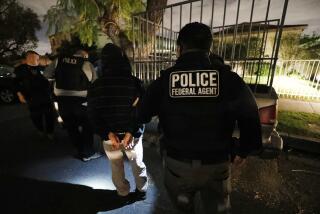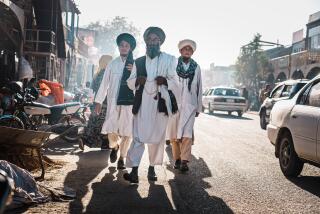U.S. to Use Leaflets, Radio to Get Its Message to Afghan People
- Share via
WASHINGTON — First came the bombs. Then the food packets. The third wave of airdrops over Afghanistan will be words.
As it has in most other conflicts in recent years, the U.S. military is preparing to drop leaflets and transmit radio broadcasts into Afghanistan as part of a broader psychological war designed to demoralize enemy troops, counter anti-American slogans and muster support among the people.
“It’s not propaganda,” Defense Secretary Donald H. Rumsfeld said Monday on Fox News. “It’s the truth. The truth is that the United States and the dozens and dozens of countries across the globe that are participating in one way or another with this effort are anxious to stop terrorism.”
Defense officials said Monday that leaflet drops--part of the military’s psychological operations, or psyops--are expected to begin shortly. They would not comment on the specific text or messages of the campaign.
Experts predict the U.S. will strive to convince Afghans that the war is not aimed at them or the Islamic faith. Rather, it will contrast Osama bin Laden’s violent acts with the peaceful teachings of the Koran. Seeking to undermine the loyalty of Taliban troops will be another key goal.
“A lot of these leaflets get wadded up and used for toilet paper, but over time it’s very helpful in convincing people that what you’re saying is right,” said William Nash, a retired Army general who now works at the Washington-based Council on Foreign Relations.
Because many Afghan citizens are unable to read, the leaflets will use symbols and pictures to help deliver their message, Rumsfeld said.
Potential images include photos of innocent bombing victims, maps directing refugees to protective camps and pictures of U.S.-supplied wheat arriving in Afghanistan, experts said.
Radio airwaves also probably will play a role. During the Persian Gulf War and conflicts in Panama and Bosnia, the Air National Guard deployed its EC-130E “Commando Solo” aircraft, which serve as flying radio stations, to block enemy signals and transmit U.S.-supported broadcasts.
Wind-up portable radios also may be smuggled into the region to increase the potential audience.
In Congress, lawmakers last week introduced a bill to set aside $14 million to create a Radio Free Afghanistan to broadcast in the same way that Radio Free Europe and Radio Liberty challenged the Communist monopoly on information in Eastern Europe.
Rep. Ed Royce (R-Fullerton), one of the bill’s chief sponsors, said that Radio Free Afghanistan urgently was needed to inform Afghans what the ruling Taliban government was doing and what was going on in the world, including the Sept. 11 terrorist attacks in the United States.
“Horrible things are being said right now that are not being countered,” Royce said. “There is a lot of anti-Semitic, anti-American, anti-Western hate radio being broadcast by the Taliban and Osama bin Laden’s organization. Radio Free Afghanistan is needed to broadcast the American ideals of democracy, liberty and freedom to listeners in the region.”
In the Gulf War, such broadcasts and other tactics led to widespread defections of Iraqi President Saddam Hussein’s troops, experts say. “It was very effective at demoralizing the enemy, wearing them down and making sure they didn’t get a wink of sleep,” said Rear Adm. (Ret.) Stephen H. Baker, a senior fellow at the Center for Defense Information.
In Iraq, U.S. psyops forces used bullhorns and leaflets to pressure beleaguered Iraqi soldiers into surrendering or retreating. U.S. Special Operations teams smuggled printing presses into Kuwait to publish anti-Iraq pamphlets.
One successful tactic involved dropping leaflets warning Iraqi soldiers that certain areas would be bombed in 24 hours. After making good on the threat several times, U.S. forces found that Iraqi soldiers had been conditioned to flee areas as soon as the leaflets were released.
The humanitarian food drops are another way to reinforce the message of the U.S. campaign, experts say. The packages include a picture of the American flag and a message that the packets were sent by the American people.
More to Read
Sign up for Essential California
The most important California stories and recommendations in your inbox every morning.
You may occasionally receive promotional content from the Los Angeles Times.











